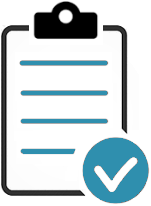To ensure that your organization is meeting its EMS policies, objectives and targets:
Contents
- 7 steps for 9.1 Monitoring, Measurement, Analysis and Evaluation
- 9.1.1 General
- Plan what Needs to be Monitored and Measured
- Developing a Process
- Identify Appropriate Indicators
- Monitoring and Measuring
- Analysing Data
- Evaluation
- Communicating Performance
- Calibrated Equipment Procedure [Template download]
The ISO 14001 emphasis is primarily placed on the continual improvement of processes and monitoring their effectiveness. You will keep records of all these observations and evaluations.
This shows evidence that your business is aware of what it needs to monitor and measure, the criteria against which the environmental performance is evaluated, including the use of appropriate indicators.

Identify criteria against which your business can measure and monitor its performance. Particular attention should be given to any criteria that needs to be communicated and where it relates to compliance obligations.
For example, a criterion could be compliance with an effluent discharge permit or compliance with chemical substance legislation.
Methods may include, as appropriate, statistical techniques to be applied to the analysis of those results.
Measuring performance against criteria can be undertaken using performance indicators.
You should expect to see that your organization has developed a process (method, techniques, format, etc.) to identify, collect and analyze various data and information from both internal and external sources, including:
This ‘input’ (information and data) should reflect upon the adequacy, suitability and effectiveness of the environmental management system and its processes.
The ‘output’ (result of the analysis) must provide information (understanding, insight, awareness, confidence, knowledge of, etc.).
Indicators help to convert relevant quantitative or qualitative information into a concise, more understandable and useful form for evaluating performance.
Indicators can comprise operational performance indicators (for example energy consumed, waste generated) and environmental condition indicators (for example concentration of specific pollutant in surrounding air).
An example of an indicator relevant to the permit could be pH or parts per million (ppm) of heavy metal. For the chemical substance legislation criterion, the indicator could be the number of suppliers responding to a questionnaire, electricity consumption, scrappage rates, production units, emissions, product fuel use and number of complaints or incidents.

Monitoring and measuring should take into account the need for reliability of data/information reliability. This depends on factors such as availability, adequacy, scientific and statistical validity and verifiability.
Monitoring and measurement should be supported by processes that ensure the data obtained are of the type, amount and quality needed for effectively evaluating performance.
For monitoring and measuring an effluent permit consent, it would be expected that a process, appropriate competency and internal audits would be in place. For chemical substance legislation, it would be expected that appropriate quality control is in place to manage records.
Analysis of information should consider the data quality, validity, adequacy and completeness and assist the organisation in its communication of reliable information.
Data analyses should include consideration of the quality, validity, adequacy and completeness of information to deem it reliable.
As such, the data and information collected through monitoring and measurement should constitute objective verifiable evidence. Such evidence allows an independent body or person to determine if a claim made by the organisation can be substantiated.
For example, an organisation claiming that it has reduced its emissions may have to provide monitoring data to back-up the claim to an interested party, if requested. Environmental auditing is a method that can be used to check the reliability of data.
Organizations are required by ISO 14001:2015 to retain appropriate documented information in the of records, spreadsheets, and reports, etc. as evidence of the monitoring, measurement, analysis and evaluation of results.
Other potential or useful options might include:
Documented information and organizational knowledge that records process data should be considered for analysis. Records are evidence of system performance and should be analyzed for potential improvements.

When data analysis is complete, the organization can evaluate its performance against the criteria. The indicators will present progress made over the reporting period and whether or not performance criteria have been met.
Evaluating performance includes evaluating the fulfilment of compliance obligations.
For evaluating performance relevant to the effluent permit consent, pH and heavy metal results would be compared to the permit consent’s emission limit values. Chemical substance legislation would require a comparison of the number of questionnaires received against the target the organisation had set itself.
Organizations should ensure that data and information which is consistent with that derived from the environmental management system are used in communications.
Communication includes internal communication, for example reporting on progress against objectives to the Top management team.
The organisation should have a process to convey knowledge and understanding of its compliance status. This should include a mechanism for regular reporting to top management on compliance status, ensuring that immediate reporting to relevant parties takes place when a non-conformance arises.
All of the ISO 14001 clauses are fully-documented and explained in our Environmental Management System Template (EMS).
We have procedures, templates, checklists, process maps, forms and gap analysis tools to help your documentation without missing a single input or output.
Before you invest all the hours reinventing the wheel, before you spend countless dollars outsourcing the task — try our templates.
Updated: 26th February 2022
Author: Richard Keen

Richard is our Compliance Director, responsible for content & product development.
But most importantly he is ISO's biggest fanboy and a true evangelist of the standards.
Learn more about Richard

Don’t Try to Manage It All Alone!
Our ISO Auditors and Quality Manager Trainers have been in this industry for years, and since 2002 we’ve been providing thousands of small businesses and large corporations with the tools they need to get certified.
Instead of trying to create everything you need to follow this process from scratch, use ours. We have procedures, templates, checklists, process maps, forms and gap analysis tools to help you control your documented information without missing a single input or output.
Before you invest all the hours reinventing the wheel, before you spend countless dollars outsourcing the task — try our templates.
| QMS ISO 9001 |
EMS ISO 14001 |
OH&S ISO 45001 |
|
|
Calibrated Equipment Procedure The purpose of this procedure is to ensure that all inspection and test equipment used for product, service and process verification is controlled and calibrated against nationally traceable standards at specified intervals and that such devices are available to ensure continuity of measurement capability. Forms & Reports also included:
>> Free Download - Control of Calibrated Equipment Procedure - this will give you a good idea of what to expect when you purchase the procedure. |
$19 USD |
Pay by Credit Card, Debit Card, PayPal or Apple Pay.


|
Please read our Money Back Guarantee. |
Bought by Small Businesses and Large Corporations our templates have been sold online and CD since 2002.
Used by:
The Templates are used by first-timers following our step-by-step, clause-by-clause guidance documents; and experienced Quality Managers wishing to streamline and improve their existing documentation.
The application of our templates is scalable and generic; regardless of the size and type of organization. The elements that form the quality management system are the same.
1. Our customizable templates save you time and money by offering a streamlined process to create your quality documentation
2. They’ve got everything you need in one simple template
3. Proven to work our templates have helped thousands of businesses big and small achieve certification
4. Documents use styles to make reformatting and rebranding a breeze
5. Our templates are generalizable for any industry or sector. The application of our templates is scalable and generic; regardless of the size and type of organization.